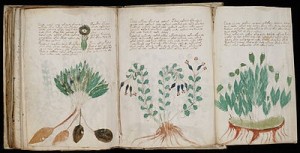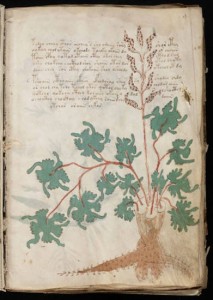Nearly Three Years Later: A Manuscript That (Still) Can’t be Read
March 3, 2014 Update: I first wrote about the Voynich Manuscript on this blog more than two years ago. As was the case then, decipherment of the mysterious codex still continues to elude linguists and scholars, though two recent posts in the Moby Lives blog (one and two) indicate they may be getting closer to at least getting a geographical fix on the plants that are included in the extravagantly illustrated work. Julia Fleischarker reports that “Dr. Arthur Tucker of Delaware State University…writes that taking the botanical illustrations as a starting point enabled them to help place the manuscript geographically,” which he now believes to have been in Mexico. It should be said that other scholars don’t accept this explanation, and continue to believe the book may be a hundreds-year old forgery, though they offer no explanation why any talented book artists in an earlier century would’ve gone to the trouble of creating a fake book.
Original post from November 30. 2011:
“A booke…containing nothing butt Hieroglyphicks, which booke his father bestowed much time upon: but I could not heare that hee could make it out.”–son of 16th century astrologer John Dee
I love mysteries like this. The Beinecke Rare Book & Manuscript Library at Yale houses the Voynich manuscript, named for the rare book dealer who acquired it ninety-nine years ago.
Prior to Wilfrid Voynich’s purchase of it, “the codex belonged to Emperor Rudolph II of Germany. . . who purchased it for 600 gold ducats and believed that it was the work of Roger Bacon,” the 13th century English mathematician.
After Wilfrid Voynich died, it ended up at Yale when his widow sold it to another dealer, H.P. Kraus, who donated it to the Library in 1969. Though the Voynich, printed on vellum and covering some 240 pages, has been the object of much study by scholars and antiquarians, none has yet been able to decipher the language in which it’s written or discern its hidden meanings. The presentation, with dozens of illustrations, two sets of which are reproduced here, includes elements of a treatise on the cosmos, the zodiac, botanical life, human anatomy, and cooking. But the purpose of the book continues to elude even intensive examination.
This all puts me in mind of the astounding philological and linguistic accomplishments of J.R.R. Tolkien, who knew many ancient alphabets and languages, and invented more than a dozen for the denizens of Middle Earth. I’ve always loved the fact that Tolkien was on the editorial board of Doubleday’s Jerusalem Bible (1966). I recall reading that he was literate in Hittite, Aramaic, Akkadian, and Ugaritic, not to mention of course ancient Greek and biblical Hebrew.
In my naivete, it hadn’t occurred to me there are still written languages that remain terra incognita to classicists; the indecipherability of the Voynich manuscript seems to me the bibliographic analogue of anthropologists finding themselves unable to communicate with a hitherto unknown tribe they’ve discovered in the Amazon. Sadly, when tribes like that are happened upon they often suffer due to the sudden exposure and attention. Well, in the controlled humidity of the Beinecke I’m sure the Voynich ms. won’t be contracting the equivalent of a devastating disease, with crumbled and foxed pages, but exquisite preservation alone hasn’t brought the librarians and archivists any closer to riddling out the mysteries of the codex.



My suggestion to decode the Voynich Manuscript is in the fact that each of its individual pages encodes some other information . Encryption is not just a written form . There’s a whole spectrum of gnosis , which, because of the limited capabilities (eg letter runicze – oldest inscriptions are from the second and third century AD, before the Egyptian hieratic writing , etc.) were also encoded in a different form – for example, by means of signs and symbols : see semiotics – from the Greek : ” semasticos ” – significant , ” semasia ” – meaning “,” semeion ” – a sign of ” sema ” – a sign , the image signal . And in such a manner is encoded Voynich manuscript – it is not my task , classic cipher written , only symbolic rebus – ideogram . Below to better illustrate the time- historical continuum in brief , a summary of the earlier descriptions of each manuscript illustration . ( From 1R to 19R ) http://gloriaolivae.pl/
1R – Big Bang and Kolaps – cyclical nature of the universe.
1V – Approximately 4.5 – 5 billion years ago – the formation of the Earth’s crust.
2R – About 3.5 billion years ago – the first organisms .
2V – About a billion years ago – the first single-celled organisms ( eukaryotes ) .
3R – Approximately 900 – 700 million years ago – the first multi-cellular organisms .
3V – approximately 700 – 600 million years ago – the first invertebrates .
4R – 500 million years ago – the first vertebrates .
4V – 400 million years ago – vertebrates came out of the water.
5R – 220 million years ago – the beginning of the reign of the dinosaurs.
5V – 65 million years ago – extinction of the dinosaurs , evolution of mammals .
6R – About 65 – 30 million years ago – carnivores .
6V – About 30 – 7 million years ago – the formation of plants and animals.
7R – About 12 million years ago – the first hominids .
7V – About 7 – 5 million years ago – the appearance of man .
8R – About 100 thousand . years ago – the emergence of modern man .
8V – Approximately 15-12 thousand . years ago – man hiking – “bridge” Bering .
9R – Approximately 11.5 thousand . years ago – the end of the last ice age.
9V – About 10 thousand . years ago – hunter -gatherers , the birth of agriculture.
10R – Around 4000 , the BC – Development of urban community Mesopotamia.
10V – Around 3000 , the BC – The beginnings of civilization of ancient Egypt.
11R – The turn of the second and first millennium BC – Judaism , Jerusalem.
11V – turn of the century – Christianity . Rome .
12R – None. According to me – Ancient Greece .
12 V – None. According to me – the Empire of Alexander the Great .
13R – The Roman Empire .
13V – Persian Empire .
14R – Huns . Mongol Empire .
14V – Byzantine Empire .
15R – The State of the Franks.
15V – The spread of Islam.
16R – Vikings .
16V – Slavs .
17R – The Crusades .
17V – The Hundred Years War .
18R – Ottoman Empire .
18V – War of the Roses .
19R – The Order of the Teutonic Knights .
Thank you for visiting my blog and for your comment.